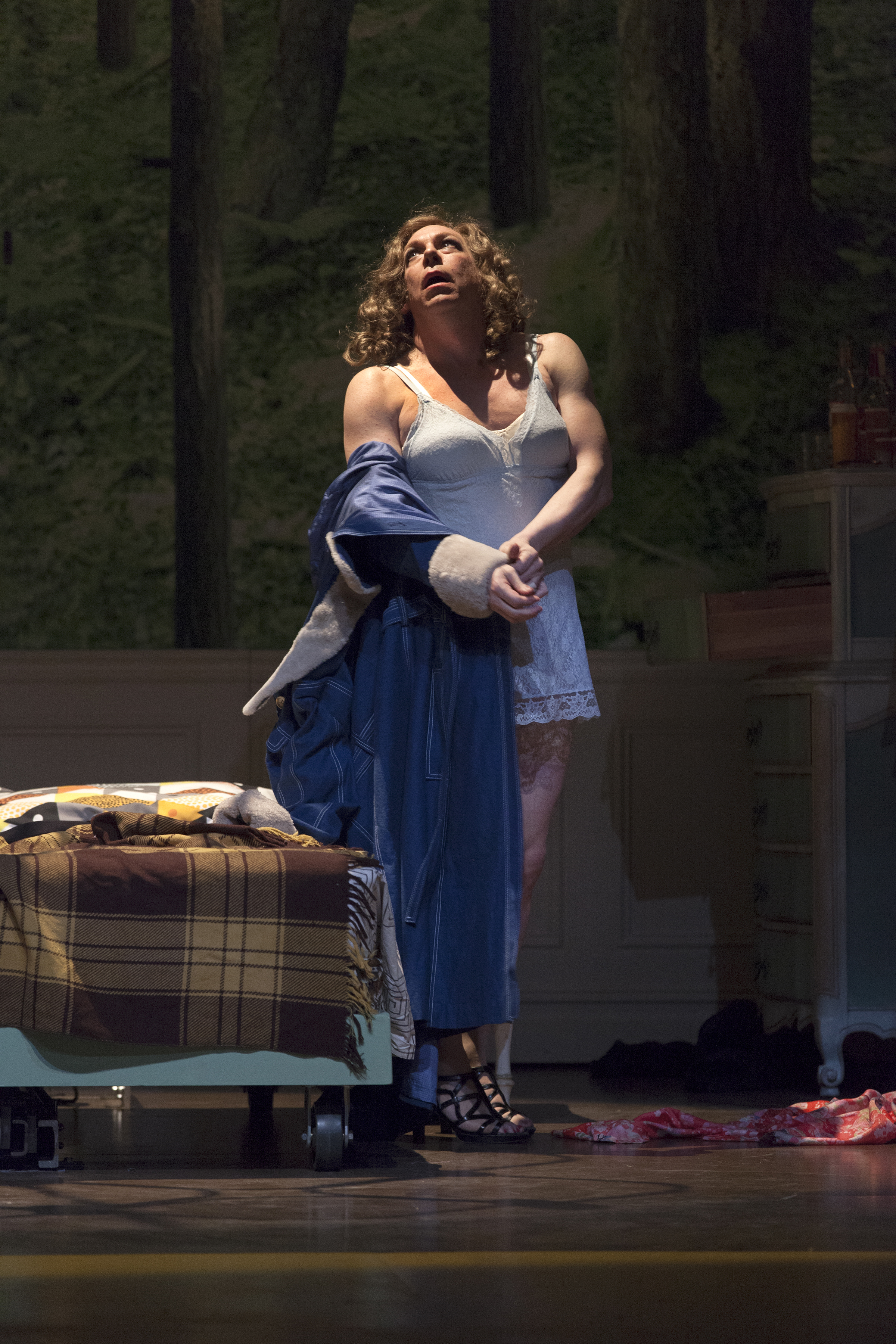Review of The Bitter Tears of Petra von Kant, Yale Cabaret
Tired of fame, film icon Greta Garbo declared, “I vant to be alone.” Petra von Kant, the heroine of Rainer Werner Fassbinder’s The Bitter Tears of Petra von Kant, is the kind of self-involved diva who can’t bear to be alone. Directed by Leora Morris with Jesse Rasmussen, Fassbinder’s meditation on the vagaries of passionate love is also a character study that plays into considerations of how, for instance, all of a star’s or a director’s relationships are scripted with a central player and a supporting cast.
Played by Sydney Lemmon with a lithe sense of grand dame status, Petra is a successful fashion designer who lords it over her underling Marlene (Anna Crivelli, icily Germanic in a silent role) and holds court in her bedroom. The room, in Christopher Thompson and Claire DeLiso’s lush set, is essentially a large double bed framed by chairs and settees, a table with a typewriter, a turntable with LPs, and the ever-important house-phone on a pedestal. There are diaphanous red drapes that sometimes are drawn or opened by Marlene, who acts as both factotum and voyeur.
Sydney Lemmon as Petra von Kant
What Marlene gazes upon, as do we, is the social and erotic life of Petra. The two sides come together quickly when a visit from her well-set-up cousin Sidonie (Annelise Lawson)—in which the two women share details of happy and unhappy marriages (Petra has had one of each)—results in Petra’s meeting with Sidonie’s young friend Karin (Baize Buzan). For Petra, the meeting seems to be love at first sight, or at least it’s a really hot meet. The next scene, when Karin calls alone upon Petra, who insists she should become a model, is filled with the expectation of seduction. Petra may be changeable and peremptory, but her attachment to Karin while egotistical is also vulnerable. Karin, played with deer-in-the-headlights allure by Buzan, seems ready to become whatever Petra wants her to be.
Then comes the crash, by degrees. Fassbinder’s heart is in this one and Petra’s suffering for her ideal of love is a masochist’s delight. Having made Karin an arbiter of her happiness, she can only be made unhappy by the least sign of her object’s indifference. And Buzan is wonderful at rendering the kind of erotic self-possession that drives Petra wild. And she’s able to do so while also seeming to be much younger than Lemmon, whose probing questions and efforts to manage her lover’s life as she does her own career reminded me of the assured but apprehensive tone often struck by Judy Davis.
Eventually, as Karin’s background comes out—the working-class father who lost his job and killed Karin’s mother in a drunken rage then hanged himself; the estranged husband in Australia—we can see that Petra’s attempts to makeover Karin are going to have more lasting effects on herself than on her protégé. The fact that Karin has not given up men—the more casual, the better—becomes the source of the title’s bitter tears. And of the vicious abuse of the user by the used.
In the birthday scene that follows Karin’s departure to meet her errant husband’s return, we see Petra go to pieces by abusing those still close to her: her young daughter Gabrielle (Leyla Levi), Sidonie, who comes bearing a gift, and Petra’s mother Valerie (Shaunette Renée Wilson). In each case, there’s a sense of the cost of loving someone like Petra, but there’s also a sense—key to the notion of a central player—that all these females depend upon her to some degree. And all are quite able to act out in their subordinate roles: Sidonie with indignation; Gabrielle with earnest need for approval; Valerie with long-suffering attachment.
Masochism, then, is in the nature of love for one’s superiors, however we interpret the latter term, and Fassbinder lets that play out, while Morris and Rasmussen manage to find a tone between melodrama and camp. In the end, Petra’s relatives are used to her, and Karin has not, perhaps, disappeared for good (why abandon a powerful supplicant?), while Petra may learn to give Marlene her due, if not too late.
What we’re left with, I suppose, is a hope that some mutually helpful caring can be reached in a reciprocal fashion, but is that possible when the ups and downs of emotional investment are here as volatile as an unstable stock market?
Mention as well for the excellent use of songs emanating from Petra’s turntable, particularly The Walker Brother’s highly apropos “In My Room,” with its grandiose melancholy. A perfect song for when you vant to be alone with your own bitter tears.
The Bitter Tears of Petra von Kant
By Rainer Werner Fassbinder
Translated by Anthony Vivis
Directed by Leora Morris
Associate Director: Jesse Rasmussen; Dramaturg & Producer: Maria Inês Marques; Co-Scenic Designers: Christopher Thompson, Claire DeLiso; Costume Designer: Haydee Zelideth Antunano; Co-Lighting Designers: Andrew F. Griffin Elizabeth Green; Sound Designer & Composition: Frederick Kennedy, Christopher Ross-Ewart; Stage Manager: Avery Trunko; Co-Technical Designers: Mike Best, Mitchell Crammond, Mitch Massaro, Sean Walters
Yale Cabaret, March 31-April 2, 2016




